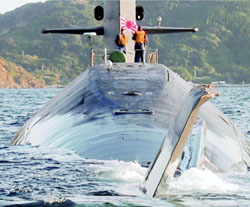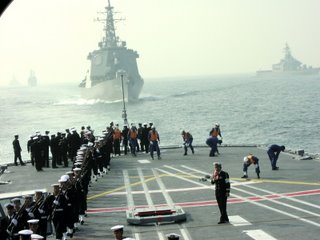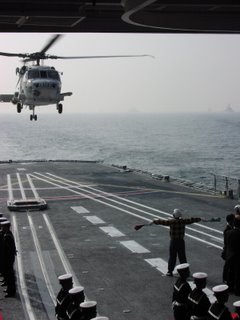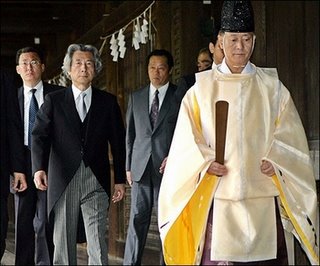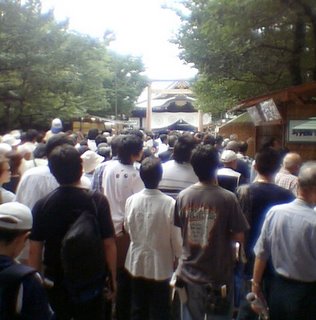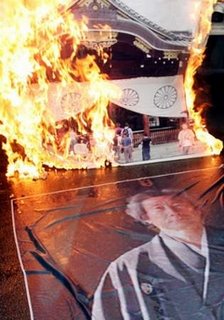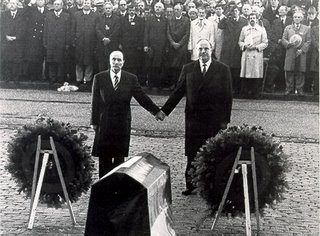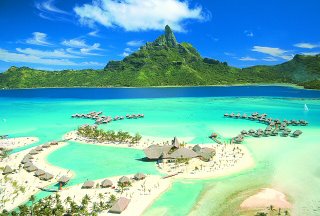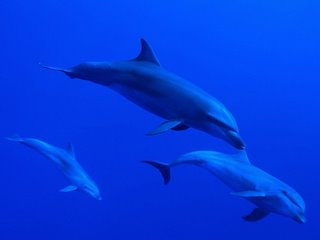
[Update 06 September 2006 08h30 am]
Princess Kiko, wife of Prince Akishino, gave birth to
a boy at 8:27 a.m. Wednesday September 6th 2006 at
Aiiku Hospital in Minato Ward, Tokyo, where she was
hospitalized and underwent a cesarean section, the
Imperial Household Agency said. The newborn prince is
the third in line to the Imperial throne, next to
Crown Prince Naruhito and Prince Akishino. It was the
first birth of a prince since 1965, when Prince
Akishino was born. The baby weighed 2,558 grams and
was 48.8 centimeters in length, according to the
agency. Both Princess Kiko and the baby are in good
health, according to the agency.
The Imperial Household Agency had initially announced
in February the baby was expected to be born in late
September. Princess Kiko had placenta previa
partialis--the partial clogging of the orifice of the
uterus--and doctors were concerned she might suffer a
hemorrhage. To ensure a safe delivery, Masao
Nakabayashi, head of Aiiku Hospital and the physician
in attendance for the princess, conducted the cesarean
section. Prince Akishino was at the hospital at the
time of the birth. The Emperor and Empress were
informed of the baby's birth by the prince himself.
The name of the newborn prince will be announced at
the Meimei no Gi, the Imperial naming ceremony, to be
held next Tuesday. The new prince is the couple's
third child following Princess Mako, 14, who is in the
third year at Gakushuin Girls' Junior High School, and
Princess Kako, 11, who is in the sixth year at
Gakushuin Primary School. The baby boy is the fourth
grandchild for the Emperor and Empress. With the
prince's birth, the Imperial family now has 23
members. In the Imperial family, nine female members
were born in a row since 1969, when Princess Sayako
was born as the only daughter of the Emperor and
Empress. Princess Sayako relinquished her royal
status on Nov. 15 last year by marrying Yoshiki
Kuroda, a Tokyo metropolitan government official.
Article 1 of the Imperial House Law stipulates that
the Imperial throne is succeeded by male heirs of the
male line of the Imperial family. As the new prince
is third in line to the throne, the positions of
Prince Hitachi, Prince Mikasa, Prince Tomohito of
Mikasa and Prince Katsura, who were previously third
to sixth in line, respectively, have been lowered by
one. Since 1779, when the 119th emperor ascended the
throne, the Imperial throne has been succeeded from
father to son--from Emperor Kokaku to Emperor Ninko,
Emperor Komei, Emperor Meiji, Emperor Taisho, Emperor
Showa to his majesty today. If the crown prince
ascends the throne and is survived by Prince Akishino,
the throne will shift to the bloodline of the younger
brother, as long as the Imperial family makeup does
not change. A recent case in which a royal throne was
transferred from an elder brother to a younger brother
occurred in Belgium in July 1993. After King Baudouin
died, his younger brother, Albert II, succeeded to the
throne. (Press DY)

Image : Princess Kiko of the Japan Imperial family.
Date: 8/26/2006 2:10:00 PM
From: Joel J. Legendre
Subject: NBR'S JAPAN FORUM (POL) Japan Imperial family
childbirth
Dear Japan forum members,
The question burns every news-desks. Explanations and
comments from scholars and experts would be most
appropriate regarding the royal pregnancy of Princess
Kiko.
What consequences if Princess Kiko does not give birth
to a baby boy?
What will happen if Princess Kiko gives birth to a
baby boy?
Regards,
Joel J. Legendre
Tokyo
www.rtl.fr
"Agences Tokyo, 31/08 La princesse Kiko, belle-fille de
l`Empereur du Japon, va très bientôt accoucher d`un
garçon, le premier héritier mâle au sein de la famille
impériale depuis plus de 40 ans, susceptible de monter
un jour sur le trône du Chrysanthème, affirme jeudi un
hebdomadaire populaire.
Selon le Shukan Bunshun, souvent bien informé sur les
affaires de la famille impériale, l`époux de Kiko, le
prince Akishino, a confié à l`un de ses amis proches
que sa femme attendait un garçon.
La nouvelle, que le Japon attend avec impatience, est
un secret très bien gardé depuis trois mois. Mais les
cercles politiques, les spécialistes d`obstétrique et
les journalistes qui tiennent les rubriques de la Cour
sont persuadés qu`il s`agit d`un garçon."
Wait and See! Anyhow the next in line is Crown Prince
Naruhito the husband of Princess Masako. Then the
Prince Akishino. Should the royal baby to be born be
a baby boy, he will be a royal dynastic back up, third
in line, securing the royal linage! But a kind of
disillusion for many women who expected the Princess
Aiko, daughter of the Crown Prince Naruhito to become
the first Japanese Empress of the 21st Century, as a
symbol of respect for gender equality.

Prince Akishino & Princess Kiko
National debate ? Not much.
Occasionally, equal primogeniture has won in
historical cases of Japanese succession: While it is
true that most succession events in Japan had since
time immemorial went in favor of a male heir, not
necessarily the eldest of the sons themselves, it
nevertheless is established by two precedents [of 1629
CE and of 642 CE] that an imperial princess may ascend
the throne in preference and prior to her younger
brothers. In 1629, the imperial princess Okiko
ascended the Japanese throne as Reigning Empress
Meisho tenno, as successor of her father, prior to her
younger half-brother and other males. Only after her
abdication 14 years later, her brother Tsuguhito
(Emperor Go-Komyo tenno) ascended. However, her
offspring would never have been allowed to ascend the
throne.
- Commentary :
Arguments in favour of primogeniture
Primogeniture prevents the subdivision of estates and
diminishes internal pressures to sell property (for
example, if two children inherit a house and one
cannot afford to buy out the other's share). In
Western Europe most younger sons of the nobility,
having no prospect of inheriting land or property,
were obliged to seek careers in the Church, the Armed
Forces or in Government. Wills often included
bequests to a monastic order who would take the
disinherited. Many of the Spanish Conquistadors were
young sons who had to make their fortune in war. In
the late 17th and early 18th Centuries, many
specifically chose to leave England for Virginia in
the Colonies. Most, if not almost all, of the early
Virginians who were plantation owners were such
younger sons who had left England because of
primogeniture laws. These Founding Fathers of the
United States of America were nearly universally
descended from the landed gentry of England, with many
being descended from English Kings of the late 14th
and early 15th Centuries, especially through the
prodigious offspring of Edward III of England.
William Shakespeare's King Lear can be seen as an
argument in favor of primogeniture as the tragically
flawed action of Lear is dividing his country into
three amongst his daughters. The division of his land
marks the beginning of the unraveling of everything
else in the play.
Arguments against primogeniture
The fact that the eldest son "scooped the pool" often
led to ill-feeling amongst younger sons (and of course
daughters). Through marriage, estates inherited by
primogeniture were combined and some nobles achieved
wealth and power sufficient to pose a threat even to
the crown itself. Alternately, one might think that,
as with most property, the land will go to its most
useful purpose no matter what the initial distribution
(the Coase Theorem). Finally, nobles tended to
complain about and resist rules of primogeniture
(though this opposition might indicate primogeniture
among nobles was good for the king).

A case of agnatic primogeniture is exemplified in the
French royal milieu, the Salic Law (attributed to the
Salian Franks) forbade any inheritance of a crown
through the female line. This accounts for the
dispute over the legitimate successor of Charles IV of
France (Edward III of England or Philip VI of France),
the separation between Hanover (where Ernest I
succeeded) and the United Kingdom upon the accession
of Queen Victoria in 1837, the separation of the
(arch)ducal house of Luxembourg from the royal house
of the Netherlands, and partially explains the role of
Carlism in Spain.
Now... this is the 21st century... right?

